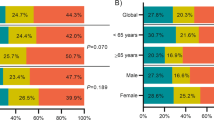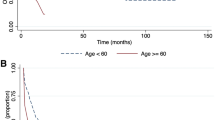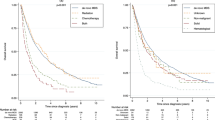Abstract
The benefit of azacitidine treatment in survival of high-risk myelodysplastic syndromes (MDS) patients compared with conventional care treatment (CCT) has not been established outside clinical trials. To assess its effectiveness, we compared overall survival (OS) between azacitidine and conventional treatment (CCT) in high-risk MDS patients, excluding those undergoing stem cell transplantation, submitted to the Spanish MDS registry from 2000 to 2013. Several Cox regression and competing risk models, considering azacitidine as a time-dependent covariate, were used to assess survival and acute myeloblastic leukemia (AML) progression. Among 821 patients included, 251 received azacitidine. Median survival was 13.4 (11.8–16) months for azacitidine-treated patients and 12.2 (11–14.1) for patients under CCT (P=0.41). In a multivariate model, age, International prognostic scoring system and lactate dehydrogenase were predictors of OS whereas azacitidine was not (adjusted odds ratio 1.08, 95% confidence interval 0.86–1.35, P=0.49). However, in patients with chromosome 7 abnormalities, a trend toward a better survival was observed in azacitidine-treated patients (median survival 13.3 (11–18) months) compared with CCT (median survival 8.6 (5–10.4) months, P=0.08). In conclusion, our data show that, in spite of a widespread use of azacitidine, there is a lack of improvement in survival over the years. Identification of predicting factors of response and survival is mandatory.
This is a preview of subscription content, access via your institution
Access options
Subscribe to this journal
Receive 12 print issues and online access
$259.00 per year
only $21.58 per issue
Buy this article
- Purchase on Springer Link
- Instant access to full article PDF
Prices may be subject to local taxes which are calculated during checkout




Similar content being viewed by others
References
Tefferi A, Vardiman JW . Myelodysplastic syndromes. N Engl J Med 2009; 361: 1872–1885.
Greenberg P, Cox C, LeBeau MM, Fenaux P, Morel P, Sanz G et al. International scoring system for evaluating prognosis in myelodysplastic syndromes. Blood 1997; 89: 2079–2088.
Greenberg PL, Tuechler H, Schanz J, Sanz G, Garcia-Manero G, Sole F et al. Revised international prognostic scoring system for myelodysplastic syndromes. Blood 2012; 120: 2454–2465.
Malcovati L, Germing U, Kuendgen A, Della Porta MG, Pascutto C, Invernizzi R et al. Time-dependent prognostic scoring system for predicting survival and leukemic evolution in myelodysplastic syndromes. J Clin Oncol 2007; 25: 3503–3510.
Fenaux P, Mufti GJ, Hellstrom-Lindberg E, Santini V, Finelli C, Giagounidis A et al. Efficacy of azacitidine compared with that of conventional care regimens in the treatment of higher-risk myelodysplastic syndromes: a randomised, open-label, phase III study. Lancet Oncol 2009; 10: 223–232.
Silverman LR, Demakos EP, Peterson BL, Kornblith AB, Holland JC, Odchimar-Reissig R et al. Randomized controlled trial of azacitidine in patients with the myelodysplastic syndrome: a study of the cancer and leukemia group B. J Clin Oncol 2002; 20: 2429–2440.
Swerdlow SH, Campo E, Harris NL, Jaffe ES, Pileri SA, Stein H et al WHO Classification of Tumours of Haematopoietic and Lymphoid Tissues. IARC: Lyon, France, 2008.
Brothman AR, Persons DL, Shaffer LG . Nomenclature evolution: changes in the ISCN from the 2005 to the 2009 edition. Cytogenet Genome Res 2009; 127: 1–4.
Simon R, Makuch RW . A non-parametric graphical representation of the relationship between survival and the occurrence of an event: application to responder versus non-responder bias. Stat Med 1984; 3: 35–44.
Arenas-Fernandez J, Fernandez-Martin JL, Cannata-Andia JB, Martinez-Camblor P . [Observational studies: the hazard and other gods]. Med Clin (Barc) 2014; 142: 80–84.
Cannata-Andia JB, Fernandez-Martin JL, Locatelli F, London G, Gorriz JL, Floege J et al. Use of phosphate-binding agents is associated with a lower risk of mortality. Kidney Int 2013; 84: 998–1008.
Fine JP, Gray RJ . A Proportional Hazards Model for the Subdistribution of a Competing Risk. J Am Statist Assoc 1999; 94: 496–509.
Itzykson R, Thepot S, Quesnel B, Dreyfus F, Beyne-Rauzy O, Turlure P et al. Prognostic factors for response and overall survival in 282 patients with higher-risk myelodysplastic syndromes treated with azacitidine. Blood 2011; 117: 403–411.
Bhatia S . Therapy-related myelodysplasia and acute myeloid leukemia. Semin Oncol 2013; 40: 666–675.
Bally C, Thepot S, Quesnel B, Vey N, Dreyfus F, Fadlallah J et al. Azacitidine in the treatment of therapy related myelodysplastic syndrome and acute myeloid leukemia (tMDS/AML): a report on 54 patients by the Groupe Francophone Des Myelodysplasies (GFM). Leuk Res 2013; 37: 637–640.
Seymour JF, Dohner H, Butrym A, Wierzbowska A, Selleslag D, Jang JH et al. Azacitidine vesrus conventional care regimens in older patients with newly diagnosed acute myeloid leukemia (>30% bone marrow blasts) with morphologic dysplastic changes: a subgroup analysis of the AZA-AML-001 trial. Blood 2014; 124: 10 [abstract].
Maynadie M, De Angelis R, Marcos-Gragera R, Visser O, Allemani C, Tereanu C et al. Survival of European patients diagnosed with myeloid malignancies: a HAEMACARE study. Haematologica 2013; 98: 230–238.
Goldberg SL, Chen E, Corral M, Guo A, Mody-Patel N, Pecora AL et al. Incidence and clinical complications of myelodysplastic syndromes among United States Medicare beneficiaries. J Clin Oncol 2010; 28: 2847–2852.
Dinmohamed AG, Visser O, van Norden Y, Huijgens PC, Sonneveld P, van de Loosdrecht AA et al. Trends in incidence, initial treatment and survival of myelodysplastic syndromes: a population-based study of 5144 patients diagnosed in the Netherlands from 2001 to 2010. Eur J Cancer 2014; 50: 1004–1012.
Rollison DE, Howlader N, Smith MT, Strom SS, Merritt WD, Ries LA et al. Epidemiology of myelodysplastic syndromes and chronic myeloproliferative disorders in the United States, 2001-2004, using data from the NAACCR and SEER programs. Blood 2008; 112: 45–52.
Stauder R, Nosslinger T, Pfeilstocker M, Sperr WR, Wimazal F, Krieger O et al. Impact of age and comorbidity in myelodysplastic syndromes. J Natl Compr Canc Netw 2008; 6: 927–934.
Germing U, Hildebrandt B, Pfeilstocker M, Nosslinger T, Valent P, Fonatsch C et al. Refinement of the international prognostic scoring system (IPSS) by including LDH as an additional prognostic variable to improve risk assessment in patients with primary myelodysplastic syndromes (MDS). Leukemia 2005; 19: 2223–2231.
Acknowledgements
We thank all the contributors to the Spanish Registry of Myelodysplastic Syndromes for their efforts to keep the database. We also thank Teresa Cedena, Beatriz Arrizabalaga, Almudena Fernández, Fernando Ramos, Nicolas Diaz, Rosa Coll, María Calbacho, Jose Falantes, Bernardo González and Santiago Bonanad for their help to collect additional data.
Author information
Authors and Affiliations
Consortia
Corresponding author
Ethics declarations
Competing interests
TB has served as advisory board member and consultant for Celgene. DV is part of the speaker bureau of Celgene, Amgen, GSK, Novartis, MSD and astellas, and member of advisory boards for Celgene, Amgen, GSK and Pfizer. GS has received honoraria and research funding from Celgene, Novartis and Amgen, and is on the advisory committee for Amgen, Böehringer-Ingelheim, Celgene, Merck-Sharp and Dohme and Novartis. The Spanish Group on Myelodysplastic Syndromes is sponsored by Celgene and Novartis. The remaining authors declare no conflict of interest.
Additional information
Supplementary Information accompanies this paper on the Leukemia website
Supplementary information
Rights and permissions
About this article
Cite this article
Bernal, T., Martínez-Camblor, P., Sánchez-García, J. et al. Effectiveness of azacitidine in unselected high-risk myelodysplastic syndromes: results from the Spanish registry. Leukemia 29, 1875–1881 (2015). https://doi.org/10.1038/leu.2015.115
Received:
Revised:
Accepted:
Published:
Issue Date:
DOI: https://doi.org/10.1038/leu.2015.115
This article is cited by
-
Hypomethylating agents (HMAs) show benefit in AML rather than in intermediate/high-risk MDS based on genetic mutations in epigenetic modification (EMMs): from a retrospective study
Annals of Hematology (2024)
-
Real-world data of MDS and CMML in Japan: results of JALSG clinical observational study-11 (JALSG-CS-11)
International Journal of Hematology (2024)
-
Myelodysplastic syndromes mortality in Spain: a comprehensive age-period-cohort and joinpoint analysis
Clinical and Translational Oncology (2023)
-
Myelodysplastic syndromes
Nature Reviews Disease Primers (2022)
-
Finding consistency in classifications of myeloid neoplasms: a perspective on behalf of the International Workshop for Myelodysplastic Syndromes
Leukemia (2022)



